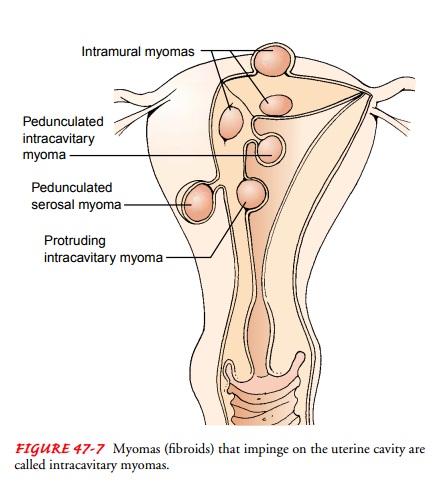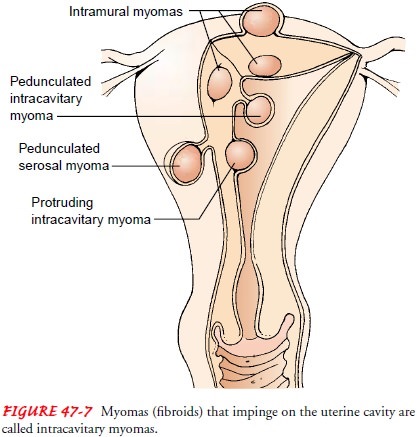Chapter: Medical Surgical Nursing: Management of Patients With Female Reproductive Disorders
Benign Tumors of the Uterus:Fibroids (Leiomyomas, Myomas)

BENIGN
TUMORS OF THE UTERUS:FIBROIDS (LEIOMYOMAS, MYOMAS)
Myomatous
or fibroid tumors of the uterus are
estimated to occur in 25% of women over age 30. Some women are geneti-cally
predisposed. They are a common reason for hysterectomy as they often result in
menorrhagia that can be difficult to control. They arise from the muscle tissue
of the uterus and can be found in the lining (intracavitary), muscle wall
(intramural), and out-side surface (serosal) of the uterus. They develop slowly
in women between the ages of 25 and 40 and may become large. Fibroids may cause
no symptoms, or they may produce abnormal vaginal bleeding. Other symptoms are
due to pressure on the surround-ing organs and include pain, backache,
constipation, and urinary problems. Menorrhagia (excessive bleeding) and
metrorrhagia (irregular bleeding) may occur because fibroids may distort the
uterine lining (Fig. 47-7).

Medical Management
The
treatment of uterine fibroids depends to a large extent on their size,
symptoms, and location. The patient with minor symp-toms is closely monitored.
If she plans to have children, treatment is as conservative as possible. As a
rule, large tumors that produce pressure symptoms should be removed (myomectomy). The uterus may be removed
(hysterectomy) if symptoms are bother-some and childbearing is completed (see
later discussion of nursing care for a patient having a hysterectomy).
Several
other alternatives to hysterectomy have been devel-oped for the treatment of
excessive bleeding due to fibroids. These include:
· Hysteroscopic resection of myomas: a laser is used through a hysteroscope passed through the cervix; no incision or overnight stay is needed
· Laparoscopic myomectomy:
removal of a fibroid through a laparoscope inserted through a small abdominal
incision
· Laparoscopic myolysis: a
laser or electrical needles are used to cauterize and shrink the fibroid
· Laparoscopic
cryomyolysis: electric current is used to coag-ulate the fibroid
· Uterine artery
embolization: polyvinyl alcohol particles are injected into the blood vessels
that supply the fibroid, shrinking it; this procedure may result in serious
complica-tions such as pain, infection, and bleeding
Fibroids
usually shrink and disappear during menopause, when estrogen is no longer
produced. Medications (eg, leupro-lide [Lupron]) or other GnRH analogs that
induce medical menopause may be prescribed to shrink the tumors. This
treat-ment consists of monthly injections, which may cause hot flashes and
vaginal dryness. This treatment is usually short term (ie, be-fore surgery) to
shrink the fibroids, allowing easier surgery, and to alleviate anemia, which
may coexist due to heavy menstrual flow. Antifibrotic agents are under investigation
for long-term treatment of fibroids. Mifepristone (RU 486), a progesterone
an-tagonist, has also been prescribed.
Related Topics